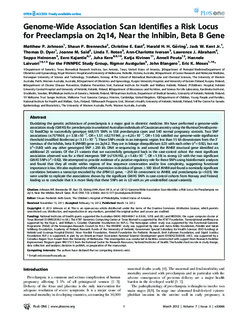| dc.contributor.author | Johnson, Matthew P | |
| dc.contributor.author | Brennecke, Shaun P. | |
| dc.contributor.author | East, Christine | |
| dc.contributor.author | Göring, Harald H H | |
| dc.contributor.author | Kent, Jack W | |
| dc.contributor.author | Dyer, Thomas D. | |
| dc.contributor.author | Said, Joanne M | |
| dc.contributor.author | Roten, Linda Tømmerdal | |
| dc.contributor.author | Iversen, Ann-Charlotte | |
| dc.contributor.author | Abraham, Lawrence J | |
| dc.contributor.author | Heinonen, Seppo | |
| dc.contributor.author | Kajantie, Eero | |
| dc.contributor.author | Kere, Juha | |
| dc.contributor.author | Kivinen, Katja | |
| dc.contributor.author | Pouta, Anneli | |
| dc.contributor.author | Laivuori, Hannele | |
| dc.contributor.author | Austgulen, Rigmor | |
| dc.contributor.author | Blangero, John | |
| dc.contributor.author | Moses, Eric K | |
| dc.date.accessioned | 2015-10-30T12:05:58Z | |
| dc.date.accessioned | 2015-11-25T11:46:02Z | |
| dc.date.available | 2015-10-30T12:05:58Z | |
| dc.date.available | 2015-11-25T11:46:02Z | |
| dc.date.issued | 2012 | |
| dc.identifier.citation | PLoS ONE 2012, 7(3) | nb_NO |
| dc.identifier.issn | 1932-6203 | |
| dc.identifier.uri | http://hdl.handle.net/11250/2365670 | |
| dc.description.abstract | Elucidating the genetic architecture of preeclampsia is a major goal in obstetric medicine. We have performed a genome-wide association study (GWAS) for preeclampsia in unrelated Australian individuals of Caucasian ancestry using the Illumina OmniExpress-12 BeadChip to successfully genotype 648,175 SNPs in 538 preeclampsia cases and 540 normal pregnancy controls. Two SNP associations (rs7579169, p = 3.58×10−7, OR = 1.57; rs12711941, p = 4.26×10−7, OR = 1.56) satisfied our genome-wide significance threshold (modified Bonferroni p<5.11×10−7). These SNPs reside in an intergenic region less than 15 kb downstream from the 3′ terminus of the Inhibin, beta B (INHBB) gene on 2q14.2. They are in linkage disequilibrium (LD) with each other (r2 = 0.92), but not (r2<0.80) with any other genotyped SNP ±250 kb. DNA re-sequencing in and around the INHBB structural gene identified an additional 25 variants. Of the 21 variants that we successfully genotyped back in the case-control cohort the most significant association observed was for a third intergenic SNP (rs7576192, p = 1.48×10−7, OR = 1.59) in strong LD with the two significant GWAS SNPs (r2>0.92). We attempted to provide evidence of a putative regulatory role for these SNPs using bioinformatic analyses and found that they all reside within regions of low sequence conservation and/or low complexity, suggesting functional importance is low. We also explored the mRNA expression in decidua of genes ±500 kb of INHBB and found a nominally significant correlation between a transcript encoded by the EPB41L5 gene, ∼250 kb centromeric to INHBB, and preeclampsia (p = 0.03). We were unable to replicate the associations shown by the significant GWAS SNPs in case-control cohorts from Norway and Finland, leading us to conclude that it is more likely that these SNPs are in LD with as yet unidentified causal variant(s). | nb_NO |
| dc.language.iso | eng | nb_NO |
| dc.publisher | Public Library of Science | nb_NO |
| dc.title | Genome-wide association scan identifies a risk locus for preeclampsia on 2q14, near the inhibin, beta B gene | nb_NO |
| dc.type | Journal article | nb_NO |
| dc.type | Peer reviewed | en_GB |
| dc.date.updated | 2015-10-30T12:05:58Z | |
| dc.source.volume | 7 | nb_NO |
| dc.source.journal | PLoS ONE | nb_NO |
| dc.source.issue | 3 | nb_NO |
| dc.identifier.doi | 10.1371/journal.pone.0033666 | |
| dc.identifier.cristin | 948306 | |
| dc.description.localcode | © 2012 Johnson et al. This is an open-access article distributed under the terms of the Creative Commons Attribution License, which permits unrestricted use, distribution, and reproduction in any medium, provided the original author and source are credited. | nb_NO |
